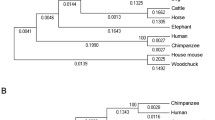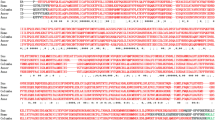Summary
Cytosolic retinoic acid-inducible gene I (RIG-I) is an important innate immune RNA sensor and can induce antiviral cytokines, e.g., interferon-β (IFN-β). Innate immune response to hepatitis B virus (HBV) plays a pivotal role in viral clearance and persistence. However, knowledge of the role that RIG-I plays in HBV infection is limited. The woodchuck is a valuable model for studying HBV infection. To characterize the molecular basis of woodchuck RIG-I (wRIG-I), we analyzed the complete coding sequences (CDSs) of wRIG-I, containing 2778 base pairs that encode 925 amino acids. The deduced wRIG-I protein was 106.847 kD with a theoretical isoelectric point (pI) of 6.07, and contained three important functional structures [caspase activation and recruitment domains (CARDs), DExD/H-box helicases, and a repressor domain (RD)]. In woodchuck fibroblastoma cell line (WH12/6), wRIG-I-targeted small interfering RNA (siRNA) down-regulated RIG-I and its downstrean effector–IFN-β transcripts under RIG-I’ ligand, 5’-ppp double stranded RNA (dsRNA) stimulation. We also measured mRNA levels of wRIG-I in different tissues from healthy woodchucks and in the livers from woodchuck hepatitis virus (WHV)-infected woodchucks. The basal expression levels of wRIG-I were abundant in the kidney and liver. Importantly, wRIG-I was significantly up-regulated in acutely infected woodchuck livers, suggesting that RIG-I might be involved in WHV infection. These results may characterize RIG-I in the woodchuck model, providing a strong basis for further study on RIG-I-mediated innate immunity in HBV infection.
Similar content being viewed by others
References
Chisari FV, Ferrari C. Hepatitis B virus immunopathogenesis. Annu Rev Immunol, 1995, 13: 29–60
Ganem D, Prince AM. Hepatitis B virus infection—natural history and clinical consequences. N Engl J Med, 2004, 350(11): 1118–1129
Law YF. Prevention and surveillance of hepatitis B virus-related hepatocellular carcinoma. Semin Liver Dis, 2005, 25(Suppl 1): 40–47
Xu CL, Hao YH, Lu YP, et al. Upregulation of toll-like receptor 4 on T cells in PBMCs is associated with disease aggravation of HBV-related acute-on-chronic liver failure. J Huazhong Univ Sci Technolog Med Sci, 2015, 35(6): 910–915
Thimme R, Wieland S, Steiger C, et al. CD8(+) T cells mediate viral clearance and disease pathogenesis during acute hepatitis B virus infection. J Virol, 2003, 77(1): 68–76
Bertoletti A, Maini MK, Ferrari C. The host-pathogen interaction during HBV infection: immunological controversies. Antiviral Ther, 2010, 15(Suppl 3): 15–24
Guo H, Jiang D, Ma D, et al. Activation of pattern recognition receptor-mediated innate immunity inhibits the replication of hepatitis B virus in human hepatocyte-derived cells. J Virol, 2009, 83(2): 847–858
Luangsay S, Ait-Goughoulte M, Michelet M, et al. Expression and functionality of Toll-and RIG-like receptors in HepaRG cells. J Hepatol, 2015, 63(5): 1077–1085
Sharma S, Fitzgerald KA. Innate immune sensing of DNA. PLoS Pathog, 2011, 7: e1001310
Yoneyama M, Kikuchi M, Natsukawa T, et al. The RNA helicase RIG-I has an essential function in double-stranded RNA-induced innate antiviral responses. Nat Immunol, 2004, 5(7): 730–737
Yoneyama M, Kikuchi M, Matsumoto K, et al. Shared and unique functions of the DExD/H box helicases RIG-I, MDA5, and LGP2 in antiviral innate immunity. J Immunol, 2005, 175(5): 2851–2858
Yoneyama M, Fujita T. Function of RIG-I-like receptors in antiviral innate immunity. J Biol Chem, 2007, 282(21): 15315–15318
Hornung V, Ellegast J, Kim S, et al. 5'-Triphosphate RNA is the ligand for RIG-I. Science, 2006, 314(5801): 994–997
Murali A, Li X, Ranjith-Kumar CT, et al. Structure and function of LGP2, a DEX(D/H) helicase that regulates the innate immunity response. J Biol Chem, 2008, 283(23): 825–15 833
Sarkar D, Desalle R, Fisher PB. Evolution of MDA-5/RIG-I-dependent innate immunity: independent evolution by domain grafting. Proc Natl Acad Sci USA, 2008, 105(44): 17040–17045
Schmidt A, Schwerd T, Hamm W, et al. 5'-triphosphate RNA requires base-paired structures to activate antiviral signaling via RIG-I. Proc Natl Acad Sci USA, 2009, 106(29): 12067–12072
Zou J, Chang M, Nie P, et al. Origin and evolution of the RIG-I like RNA helicase gene family. BMC Evol Biol, 2009, 9: 85
Takahasi K, Yoneyama M, Nishihori T, et al. Nonself RNA-sensing mechanism of RIG-I helicase and activation of antiviral immune responses. Mol Cell, 2008, 29(4): 428–440
Saito T, Hirai R, Loo YM, et al. Regulation of innate antiviral defenses through a shared repressor domain in RIG-I and LGP2. Proc Natl Acad Sci USA, 2007, 104(2): 582–587
Jiang F, Ramanathan A, Miller MT, et al. Structural basis of RNA recognition and activation by innate immune receptor RIG-I. Nature, 2011, 479(7373): 423–427
Wu B, Peisley A, Richards C, et al. Structural basis for dsRNA recognition, filament formation, and antiviral signal activation by MDA5. Cell, 2013, 152(1-2): 276–289
Loo YM, Fornek J, Crochet N, et al. Distinct RIG-I and MDA5 signaling by RNA viruses in innate immunity. J Virol, 2008, 82(1): 335–345
Saito T, Owen DM, Jiang F, et al. Innate immunity induced by composition-dependent RIG-I recognition of hepatitis C virus RNA. Nature, 2008, 54(7203): 523–527
Arnaud N, Dabo S, Akazawa D, et al. Hepatitis C virus reveals a novel early control in acute immune response. PLoS Pathog, 2011, 7(10): e1002289
Chen X, Qian Y, Yan F, et al. 5'-triphosphate-siRNA activates RIG-I-dependent type I interferon production and enhances inhibition of hepatitis B virus replication in HepG2.2.15 cells. Eur J Pharmacol, 2013, 721(1-3): 86–95
Sato S, Li K, Kameyama T, et al. The RNA sensor RIG-I dually functions as an innate sensor and direct antiviral factor for hepatitis B virus. Immunity, 2015, 42(1): 123–132
Chen MF, Lin Y, Xia YC, et al. Establishment and application of hepatitis B virus persistent replication model in IFNAR(-/-) mouse. J Huazhong Univ Sci Technolog Med Sci, 2013, 33(3): 392–327
Hao Y, Yang D. Cloning, eukaryotic expression of human ISG20 and preliminary study on the effect of its anti-HBV. J Huazhong Univ Sci Technolog Med Sci, 2008, 28(1): 11–13
Chayama K, Hayes CN, Hiraga N, et al. Animal model for study of human hepatitis viruses. J Gastroenterol Hepatol, 2011, 26(1): 13–18
Roggendorf M, Tolle TK. The woodchuck: an animal model for hepatitis B virus infection in man. Intervirology, 1995, 38(1-2): 100–112
Tennant BC, Gerin JL. The woodchuck model of hepatitis B virus infection. ILAR J, 2001, 42(2): 89–102
Wang Y, Menne S, Jacob JR, et al. Role of type 1 versus type 2 immune responses in liver during the onset of chronic woodchuck hepatitis virus infection. Hepatology, 2003, 37(4): 771–780
Wang BJ, Tian YJ, Meng ZJ, et al. Establishing a new animal model for hepadnaviral infection: susceptibility of Chinese Marmota-species to woodchuck hepatitis virus infection. J Gen Virol, 2011, 92(Pt 2): 681–691
Yang X, Hao Y, Liu Z, et al. Frequencies and characterization of HBV-specific cytotoxic Tlymphocytes in self-limited and chronic hepatitis B viral infection in China. J Huazhong Univ Sci Technolog Med Sci, 2009, 29(5): 567–574
Wang J, Michalak TI. Inhibition by woodchuck hepatitis virus of class I major histocompatibility complex presentation on hepatocytes is mediated by virus envelope pre-S2 protein and can be reversed by treatment with gamma interferon. J Virol, 2006, 80(17): 8541–8553
Lu M, Menne S, Yang D, et al. Immunomodulation as an option for the treatment of chronic hepatitis B virus infection: preclinical studies in the woodchuck model. Expert Opin Investig Drugs, 2007, 16(6): 787–801
Kosinska AD, Zhang E, Johrden L, et al. Combination of DNA prime—adenovirus boost immunization with entecavir elicits sustained control of chronic hepatitis B in the woodchuck model. PLoS Pathog, 2013, 9(6): e1003391
Tamura K, Dudley J, Nei M, et al. MEGA4: molecular evolutionary genetics analysis (MEGA) software version 4.0. Mol Biol Evol, 2007, 24(8): 1596–1599
Lu M, Lohrengel B, Hilken G, et al. Woodchuck gamma interferon upregulates major histocompatibility complex class I transcription but is unable to deplete woodchuck hepatitis virus replication intermediates and RNAs in persistently infected woodchuck primary hepatocytes. J Virol, 2002, 76(1): 58–67
Michalak TI, Hodgson PD, Churchill ND. Post transcriptional inhibition of class I major histocompatibility complex presentation on hepatocytes and lymphoid cells in chronic woodchuck hepatitis virus infection. J Virol, 2000, 74(10): 4483–4494
Bamming D, Horvath CM. Regulation of signal transduction by enzymatically inactive antiviral RNA helicase proteins MDA5, RIG-I, and LGP2. J Biol Chem, 2009, 284(15): 9700–9712
Lech M, Avila-Ferrufino A, Skuginna V, et al. Quantitative expression of RIG-like helicase, NOD-like receptor and inflammasome-related mRNAs in humans and mice. Int Immunol, 2010, 22(9): 717–728
Kubota K, Sakaki H, Imaizumi T, et al. Retinoic acid-inducible gene-I is induced in gingival fibroblasts by lipopolysaccharide or poly IC: possible roles in interleukin-1 beta, -6 and -8 expression. Oral Microbiol Immunol, 2006, 21(6): 399–406
Kuniyoshi K, Takeuchi O, Pandey S, et al. Pivotal role of RNA-binding E3 ubiquitin ligase MEX3C in RIG-I-mediated antiviral innate immunity. Proc Natl Acad Sci USA, 2014, 111(15): 5646–5651
Riedl T, Egly JM. Phosphorylation in transcription: the CTD and more. Gene Expr, 2000, 9(1-2): 3–13
Author information
Authors and Affiliations
Corresponding authors
Additional information
This project was supported by grants from the National Science and Technology Major Project for Infectious Diseases of China (No. 2012ZX10004503), the National Natural Science Foundation of China (No. 81101248, No. 81261120397 and No. 81371828), and the Deutsche Forschungs-gemeinschaft (Transregio TRR60).
Rights and permissions
About this article
Cite this article
Yan, Q., Liu, Q., Li, Mm. et al. Molecular cloning, characterization and expression analysis of woodchuck retinoic acid-inducible gene I. J. Huazhong Univ. Sci. Technol. [Med. Sci.] 36, 335–343 (2016). https://doi.org/10.1007/s11596-016-1588-5
Received:
Revised:
Published:
Issue Date:
DOI: https://doi.org/10.1007/s11596-016-1588-5




